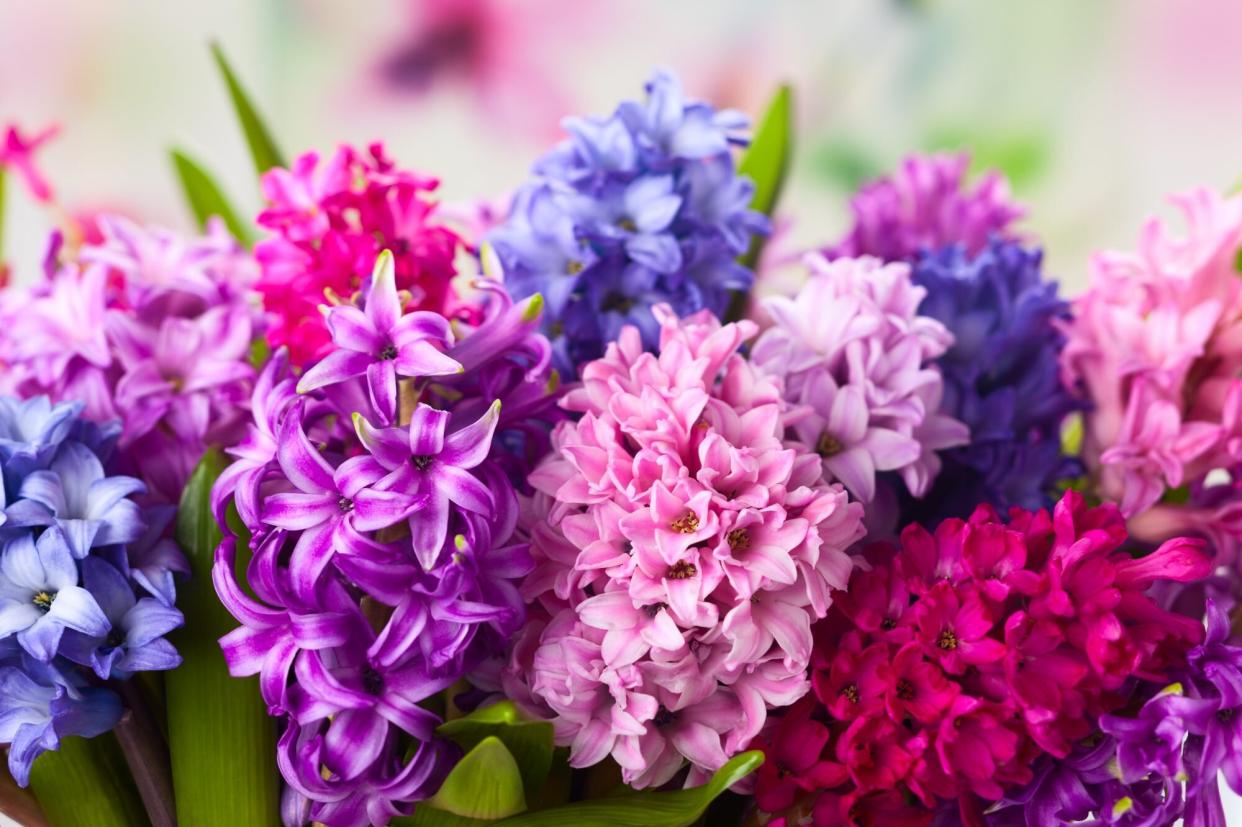The Complete Guide to Growing Hyacinths

Sarsmis/Getty Images
TABLE OF CONTENTS
On This Page
What are Hyacinths?
When to Plant Hyacinths
Which Hyacinths Should I Plant?
How to Care for Hyacinths
How to Plant Hyacinths in Containers
How to Grow Hyacinths as Perennials
How to Force Hyacinths
Potential Hyacinth Risks
Hyacinths are beautiful additions to Southern gardens. They provide vibrant floral color with tall spikes of eye-catching blooms and bright green foliage. Hyacinths are members of the Asparagaceae family; they're perennials that produce striking, fragrant flowers, the likes of which will have you looking forward to their blooms every year. Read on to learn about hyacinths and how to plant, tend, and maintain them everywhere, including in your gardens, containers, and windowsills.
What are Hyacinths?
Hyacinthus orientalis, or the common hyacinth, is a fragrant flowering plant that blooms in early to mid-spring. Hyacinths produce showy flowers in shades of blue, purple, white, pink, and red. The flowers appear in thick clusters on tall spikes; each spike is filled with small, deeply fragrant, bell-shaped blooms. Long bright green leaves form around the base of the plant.
When to Plant Hyacinths
These bulbs should be planted in autumn and can be put in the ground from October to December for flowering in the spring months (usually March and April). They're perennials but can be treated as annuals. According to The Southern Living Garden Book, the "size of the flower spike is directly related to the size of the bulb. The biggest bulbs are desirable for exhibition plants or for potting; the next largest size is satisfactory for bedding outside. Small bulbs give smaller, looser clusters with more widely spaced flowers."
Which Hyacinths Should I Plant?
The Dutch hyacinth is at home in the Upper and Middle South, but according to The Southern Living Garden Book, "it can be grown as an annual anywhere." The Roman or French Roman hyacinth (Hyacinth orientalis albulus) blooms earlier than the Dutch and "also needs little to no winter chill, making it better adapted to the Lower, Coastal, and Tropical South (where it will grow as a perennial under favorable conditions.)"
How to Care for Hyacinths
Hyacinths should be planted in well-drained soil. According to The Southern Living Garden Book, gardeners should "set larger Dutch hyacinth bulbs 6 in. deep, 5 in. apart; set smaller ones and Roman hyacinth bulbs 4 in. deep, 4-5 in. apart." The bulbs grow best in full sun or partial shade with regular watering during the growth and blooming periods.
How to Plant Hyacinths in Containers
Hyacinths are great container plants and look lovely when a large number of them are planted together in close proximity. They require good drainage when planted in pots. At first, they grow best in a porous potting mix shaded and cooled by a layer of mulch at the surface. With enough shade, the roots will form and then, after the bulbs take root, the hyacinths need plenty of sunlight (plus a consistent environment of well-drained soil).
How to Grow Hyacinths as Perennials
To tend to already-planted hyacinths for next year's blooming season, be sure to fertilize the plants as their blossoms begin to droop and fall. Snip the faded spikes and continue watering the bulbs until the foliage yellows and dies back.
How to Force Hyacinths
You can force hyacinth bulbs in a vase; all you need to do is place chilled bulbs (pointed side up and root end down) in a forcing vase, and make sure the water comes all the way up to the bottom of the bulb. Then, place the bulbs in a cool, dark place until the roots begin to develop and the plant's leaves begin to appear. Be sure to change the water regularly and keep the water level consistent. When the leaves appear, move the vase to a bright spot, like a windowsill, where they can receive full sunlight and warmer temperatures. The forced hyacinths will flower in six to eight weeks. However, the bulbs will likely not rebloom.
Potential Hyacinth Risks
Hyacinth bulbs can cause skin irritation. The plant's bulbs are partly composed of calcium oxalate crystals, which act like barbs that are invisible to the eye. They can create microscopic breaks in the skin that cause itching and irritation, so be sure to wear gloves or wash your hands thoroughly after handling bulbs and before touching your skin, face, or eyes.
Love hyacinths but want to plant outside the box? Then be sure to also read up on grape hyacinths (Muscari sp.), members of an unrelated look-alike genus, which have blooms that resemble clusters of ripe grapes. They are ideal for planting in the yard as they spread easily, quickly, and freely.
What are your favorite bulbs to plant in the garden? Do you plan on planting hyacinths in the future?